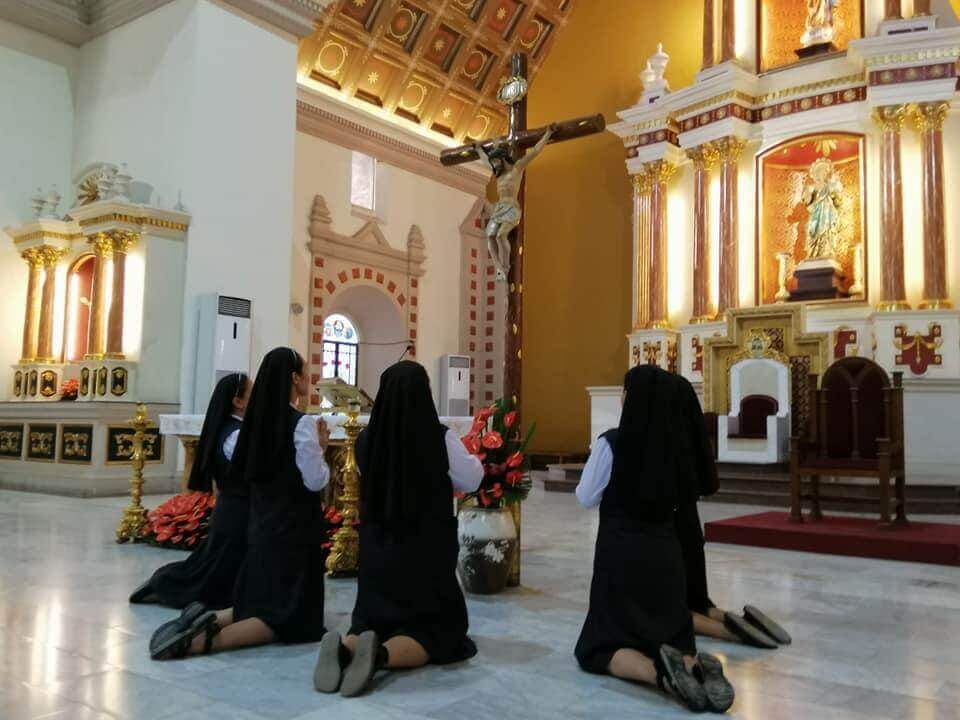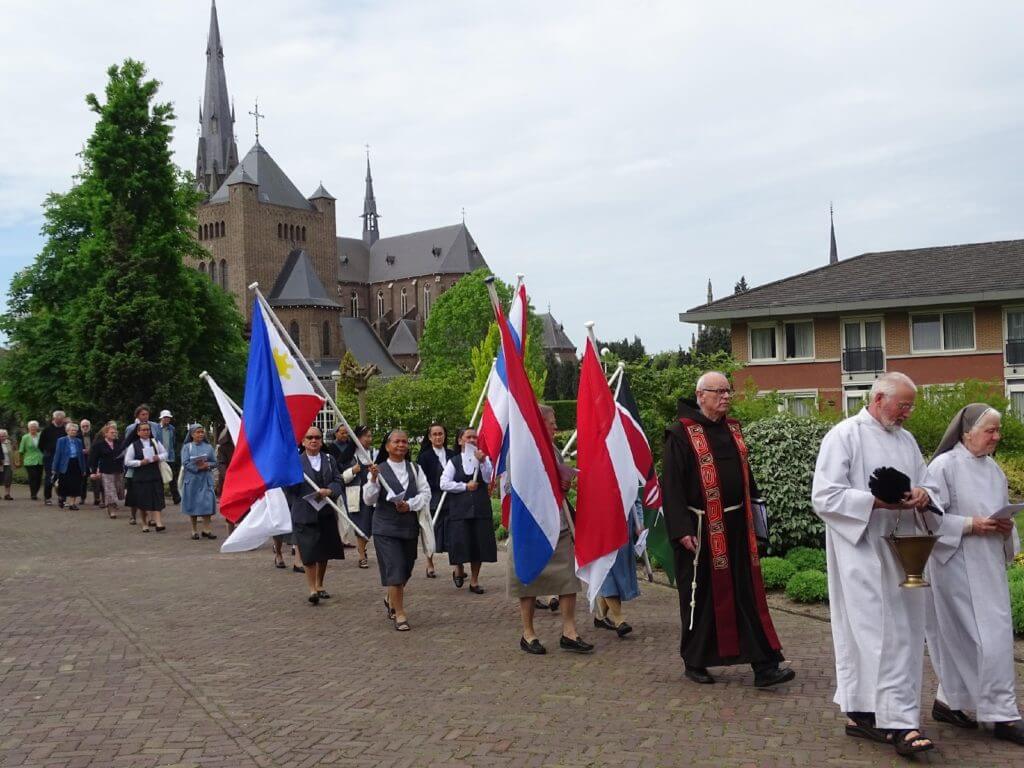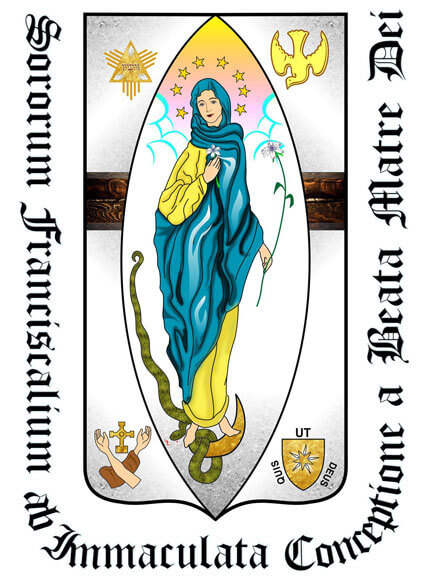Our History
Origin and Founders
The nucleus of the Congregation consisted of three young ladies who had the courage and generosity to answer God’s call to service.
On June 8, 1843, Pastor Bernardinus Joannes van Miert, then parish priest of Veghel, Netherlands, brought the three Postulants to the Novitiate of the Congregation of the Penitents-Recollectines in Roosendaal under the care of Mother Marie Joseph Raaymakers, the Superior of the Congregation.
On July 23, 1843 they received the habit as novices. Miss Jacoba Petronella van Miert received the name Sister Maria Teresia of St. Joseph, Miss Maria van Hoof took the name Sister Maria Bernardina of the Holy Name of Jesus, and Miss Maria de Roij chose the name Sister Maria Francisca of the Holy Family.
During their novitiate year at Roosendaal, Sister Augustine was their Novice Mistress, but Mother Joseph had a deep influence on the formation of the Novices from Veghel. This formation would imprint an indelible mark on their future life.
It was on September 19, 1844 that the three Sisters made their solemn profession. Msgr. Joannes Zwijsen presided over the ceremony. He established, upheld and confirmed the new Congregation himself. After an election was held in accordance with the Constitutions, Sister Teresia van Miert was appointed by Msgr. Zwijsen as general superior of the newly, solemnly founded religious community for a period of six years. She would fulfil this function till September 11, 1891.
Growth & Expansion
In the years after the foundation, the Congregation grew and prospered. After the death of Pastor van Miert on June 2, 1870, Mother Teresia was directly at the helm of the Congregation. She took charge of its administration and the spiritual needs of the Sisters. As they increased in number, they likewise spread their presence and services to other towns and cities of the Netherlands. They became actively involved in parishes and gave particular interest to education as it was the need of the time. Schools were established for orphans and the handicapped, for religious education and practical training of the youth. Their communities helped in seeking employment for the tramps and beggars. They extended their nursing care to the sick and to the elderly. As they went about in their various ministries, the Sisters’ way of life was marked by obedience and humility, simplicity and joy, love and self-giving, grounded on deep faith and trust in God. They believed that the strength of the Congregation rested upon solid virtue.

Thus it was with the same faith and trust in God that the Franciscan Sisters of Veghel responded to the call to foreign mission. On October 13, 1906, the first group of missionaries left their homeland and sailed to West Borneo with a group of Capuchin Fathers. Responding to the invitation of Msgr. Constant Jurgens, a Dutch missionary in the Philippines, five Sisters gladly accepted their mission and left for the Philippines on February 5, 1929. Both missions eventually grew into independent provinces. A General Board was chosen on November 30, 1985 to oversee the general administration of the whole Congregation.
Although a mission began in Tanzania, East Africa in 1962, their stay ended in 1975. The Kenya Mission was established on January 22, 1994 as a collaborative effort of the three provinces of Netherlands, Indonesia and the Philippines in a shared response to global concerns.
On April 17, 2000, an International Community composed of three Sisters – a Dutch, an Indonesian and a Filipina, was established in s’Hertogenbosch, Netherlands. Given the international character of our Congregation, this community is a new form of SFIC presence in the Netherlands, as they strive to be witnesses of God’s compassionate love to the poor of our times.
The International Community was discontinued in 2005. On July 10, 2000, the Indonesian Province started a community in Sulawesi Island. The Philippine Province started a community in Kamloops, Canada, on September 12, 2008. The declaration of the Philippine South Province was on April 30, 2010.

Our Franciscan Tradition
Sister Teresia and her co-sisters were formed by the Penitents-Recollectines of Roosendaal, a Congregation of Franciscan Tradition. Even after they left for Veghel and started a new Institute, they lived according to the Rule of Roosendaal and preferred nothing else but to continue this tradition. Later on Msgr. Zwijsen, the Bishop of the Diocese, required them to adopt the Rule of the Sisters of Charity. However, Sister Teresia and her co-sisters struggled to be allowed to continue wearing their habit and the Franciscan cord, and to pray the Franciscan breviary. They also placed their new foundation under the special protection of St. Francis of Assisi with the Immaculate Conception of Mary as their patroness.
Steeped in the Franciscan tradition of the Penitents-Recollectines of Roosendaal, Sister Teresia and her co-sisters kept the Franciscan spirit alive. After a long and painful process, the Bishop finally recognized the validity of the Congregation’s independence and worked for its approbation. On April 24, 1870, the Constitutions and Rules were approved and signed by Pope Pius IX.
Though they were listed among the Congregations of Franciscans in the Netherlands, it was only on September 11, 1910 that the Holy See recognized the Franciscan character of the Congregation and empowered the General Superior of the Capuchin Fathers to accomplish the aggregation to their Order. The actual incorporation was done on October 4, 1910.
The Franciscan tradition wherein Sister Teresia and her co-sisters stood was mostly inspired by the Penitents-Recollectines of Roosendaal. Mother Joseph traced their origin to Johanna of Jesus (1576-1648), the founder of the Congregation, who was known as a reformer of the conventual life. In her writings, Johanna of Jesus described the foundations which characterized her spirituality, namely:
- purity of heart to make room for what is essential: simplicity;
- humility to think less about oneself;
- mutual or reciprocal love to promote the cheerfulness of the spirit;
- and bodily mortification to protect oneself from over-indulgence.
Following the “perfect path of truth” for Johanna of Jesus means to make room for God’s love to dwell within you so that you are able to pass it on to others. Mother Joseph pursued this same path, a way of life lived in simplicity and detachment based on the love of God. She stressed that His love brings their love to life so that they can encounter the other in mutual love. This, for her, is the call of the penitents. (cf Judith de Raat, Een verborgen schat, p.20-22)
Sister Teresia van Miert, after the example of Mother Joseph, strived to live in this spirit of simplicity and submission, love and penance. Her compassion was based on the love of God. By nature we are poor in love, she said, but God loves us, the only thing that we can do then is try to love one another and our fellow beings.
